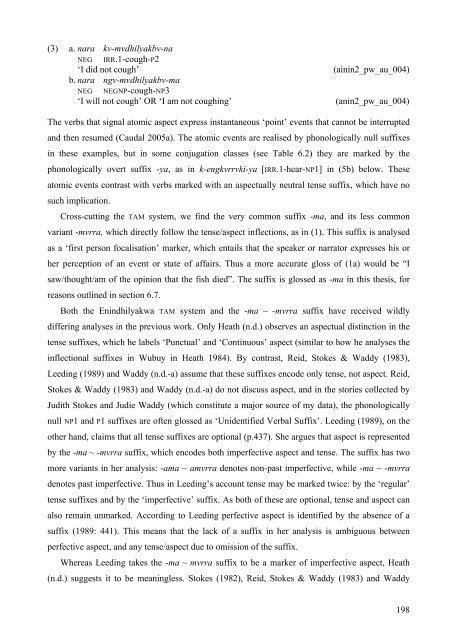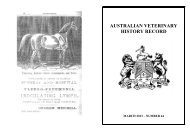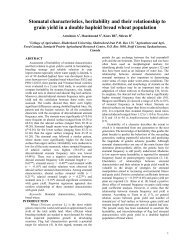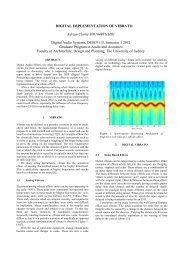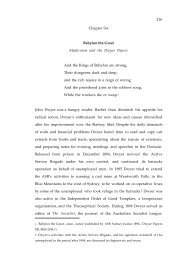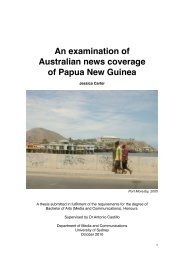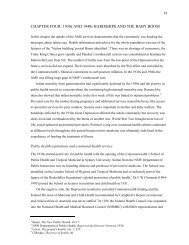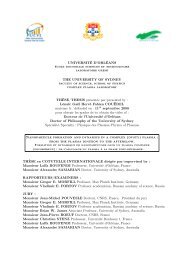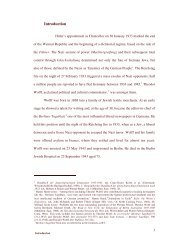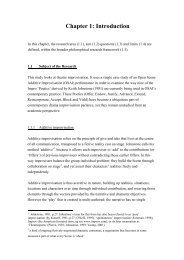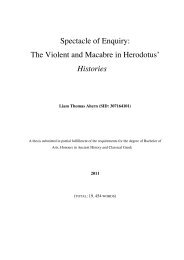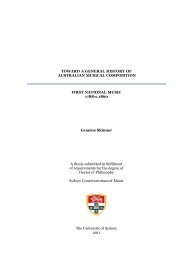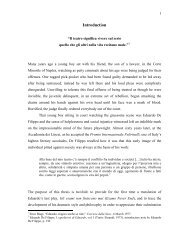Chapter 6: Tense, aspect and mood
Chapter 6: Tense, aspect and mood
Chapter 6: Tense, aspect and mood
You also want an ePaper? Increase the reach of your titles
YUMPU automatically turns print PDFs into web optimized ePapers that Google loves.
(3) a. nara kv-mvdhilyakbv-na<br />
NEG IRR.1-cough-P2<br />
‘I did not cough’ (ainin2_pw_au_004)<br />
b. nara ngv-mvdhilyakbv-ma<br />
NEG NEGNP-cough-NP3<br />
‘I will not cough’ OR ‘I am not coughing’ (anin2_pw_au_004)<br />
The verbs that signal atomic <strong>aspect</strong> express instantaneous ‘point’ events that cannot be interrupted<br />
<strong>and</strong> then resumed (Caudal 2005a). The atomic events are realised by phonologically null suffixes<br />
in these examples, but in some conjugation classes (see Table 6.2) they are marked by the<br />
phonologically overt suffix -ya, as in k-engkvrrvki-ya [IRR.1-hear-NP1] in (5b) below. These<br />
atomic events contrast with verbs marked with an <strong>aspect</strong>ually neutral tense suffix, which have no<br />
such implication.<br />
Cross-cutting the TAM system, we find the very common suffix -ma, <strong>and</strong> its less common<br />
variant -mvrra, which directly follow the tense/<strong>aspect</strong> inflections, as in (1). This suffix is analysed<br />
as a ‘first person focalisation’ marker, which entails that the speaker or narrator expresses his or<br />
her perception of an event or state of affairs. Thus a more accurate gloss of (1a) would be “I<br />
saw/thought/am of the opinion that the fish died”. The suffix is glossed as -ma in this thesis, for<br />
reasons outlined in section 6.7.<br />
Both the Enindhilyakwa TAM system <strong>and</strong> the -ma ~ -mvrra suffix have received wildly<br />
differing analyses in the previous work. Only Heath (n.d.) observes an <strong>aspect</strong>ual distinction in the<br />
tense suffixes, which he labels ‘Punctual’ <strong>and</strong> ‘Continuous’ <strong>aspect</strong> (similar to how he analyses the<br />
inflectional suffixes in Wubuy in Heath 1984). By contrast, Reid, Stokes & Waddy (1983),<br />
Leeding (1989) <strong>and</strong> Waddy (n.d.-a) assume that these suffixes encode only tense, not <strong>aspect</strong>. Reid,<br />
Stokes & Waddy (1983) <strong>and</strong> Waddy (n.d.-a) do not discuss <strong>aspect</strong>, <strong>and</strong> in the stories collected by<br />
Judith Stokes <strong>and</strong> Judie Waddy (which constitute a major source of my data), the phonologically<br />
null NP1 <strong>and</strong> P1 suffixes are often glossed as ‘Unidentified Verbal Suffix’. Leeding (1989), on the<br />
other h<strong>and</strong>, claims that all tense suffixes are optional (p.437). She argues that <strong>aspect</strong> is represented<br />
by the -ma ~ -mvrra suffix, which encodes both imperfective <strong>aspect</strong> <strong>and</strong> tense. The suffix has two<br />
more variants in her analysis: -ama ~ amvrra denotes non-past imperfective, while -ma ~ -mvrra<br />
denotes past imperfective. Thus in Leeding’s account tense may be marked twice: by the ‘regular’<br />
tense suffixes <strong>and</strong> by the ‘imperfective’ suffix. As both of these are optional, tense <strong>and</strong> <strong>aspect</strong> can<br />
also remain unmarked. According to Leeding perfective <strong>aspect</strong> is identified by the absence of a<br />
suffix (1989: 441). This means that the lack of a suffix in her analysis is ambiguous between<br />
perfective <strong>aspect</strong>, <strong>and</strong> any tense/<strong>aspect</strong> due to omission of the suffix.<br />
Whereas Leeding takes the -ma ~ mvrra suffix to be a marker of imperfective <strong>aspect</strong>, Heath<br />
(n.d.) suggests it to be meaningless. Stokes (1982), Reid, Stokes & Waddy (1983) <strong>and</strong> Waddy<br />
198


